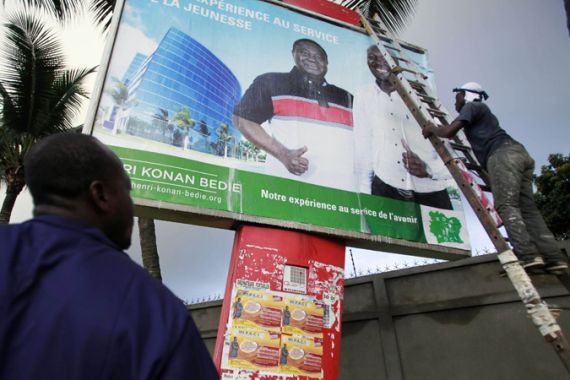Country Profile: Cote d’Ivoire

 |
| Forces loyal to Laurent Gbagbo move along a street in Abidjan, Ivory Coast [EPA] |
Three decades after independence under the leadership of its first president, Felix Houphouet-Boigny, Cote d’Ivoire was hailed for its religious and ethnic harmony and its well-developed economy. However, the country has since been plagued by internal religious and ethnic tension.
Despite government attempts to diversify the economy, it is still heavily dependent on agriculture and related activities, engaging roughly 68 per cent of the population.
Keep reading
list of 4 itemsBoeing hit with 32 whistleblower claims, as dead worker’s case reviewed
US imposes new sanctions on Iran after attack on Israel
A flash flood and a quiet sale highlight India’s Sikkim’s hydro problems
Since 2006, oil and gas production have become more important engines of economic activity than cocoa.
Cote d’Ivoire’s first president, Felix Houphouet-Boigny ruled the country for 33 years. During his rule, the country witnessed religious and ethnic harmony until his successor Henri Bedie was toppled by a coup led by Robert Guei in 1999.
Bedie fled the country, leaving behind a legacy of increased xenophobia against Muslim northerners. The same tactics were implemented by Guei, who had his political rival Alassane Ouattara banned from the presidential election in 2000 because of his foreign background.
Robert Guei was deposed in 2000 in a violent uprising that saw Laurent Gbagbo come into power. Many of Ouattara’s supporters were killed after their leader called for new elections.
Political turmoil continues to damage the country’s economy, resulting in the loss of foreign investment and slow economic growth.
Cote d’Ivoire has since been plagued by ethnic and religious tension that has left the nation tense and divided.
Independence: August 7, 1960 (from France)
Geography: West Africa, bordering the North Atlantic Ocean, between Ghana and Liberia.
Demography
Population: 21,058,798
Median age: 19.4 years
Birth rate: 31.48 births/1,000 population (2010 est.)
Death rate: 10.43 deaths/1,000 population (July 2010 est.)
Life expectancy at birth: 56.19 years
Ethnic groups: Akan 42.1 per cent, Voltaiques/Gur 17.6 per cent, Northern Mandes 16.5 per cent, Krous 11 per cent, Southern Mandes 10 per cent , other 2.8 per cent – includes 130,000 Lebanese and 14,000 French (1998)
Religions: Muslim 38.6 per cent, Christian 32.8 per cent, indigenous 11.9 per cent, none 16.7 per cent (2008 est.)
Languages: French (official), 60 native dialects with Dioula the most widely spoken
Economy:
Industries: foodstuffs, beverages, wood products, oil refining, truck/bus assembly, textiles, fertiliser, building materials, electricity, ship construction and repair
Natural resources: petroleum, natural gas, diamonds, manganese, iron ore, cobalt, bauxite, copper, gold, nickel, tantalum, silica sand, clay, cocoa beans, coffee, palm oil, hydropower.
GDP: $23.18 billion (2009 est.)
GDP/capita: $1,700 (2009 est.)
Unemployment: Approaching 40-50% as a result of the civil war
Population below poverty line: 42 per cent (2006 est.)
Exchange rate: Communaute Financiere Africaine francs (XOF) per US dollar – 469.21 (2009).